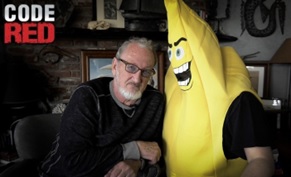

At the dawn of the DVD era, one label was synonymous with cult movies: Anchor Bay Entertainment, a consortium that owed its roots to Video Treasures and Starmaker Entertainment, a pair of VHS labels that specialized in genre fare. Thanks to a series of mergers and acquisitions, the newly formed Anchor Bay boasted an unrivaled cult catalog when DVD launched in the late ’90s, putting them in a position to dominate the market during those halcyon days when your local Best Buy became a replica of your childhood video store. All of those titles that once beckoned you with their big box or clamshell cases were suddenly available to buy on a shiny new collectible format that often promised revelatory restorations and supplemental features.
This is not to dismiss the contributions of other labels during this formative time, as the likes of Elite Entertainment, Media Blasters, and Synapse certainly carved out some space on every collector’s shelf; however, Anchor Bay’s lineup was a veritable wish list headlined by the likes of THE EVIL DEAD, HALLOWEEN, HELLRAISER, and George Romero’s LIVING DEAD trilogy, just to name a few. We joke now about the half-dozen copies of these titles we’ve accumulated in our collections, but these were momentous releases at the time, especially for those of us who only knew these titles from murky VHS tapes. Vintage Eurohorror became an early staple as well, with genre stalwarts like Dario Argento, Mario Bava, and Lucio Fulci earning their own collections. Anchor Bay also leaned into the collectability of the new format with limited edition packaging that housed elaborate liner notes and lobby cards, cementing their position as the premiere cult home video label, a position that would largely go unchallenged until Bill Lustig’s Blue Underground (itself a shell company of Anchor Bay) joined the fray with re-releases of AB titles and its own killer catalog.

 These twin pillars of exploitation and schlock would stand strong until 2007 when Anchor Bay began drifting away from the cult realm following its sale to Liberty Media. Briefly renamed Starz Home Entertainment, the company would still occasionally dabble in offbeat fare, issuing a definitive DVD of PHANTASM in 2007 and partnering with Fox to bring some of its more obscure titles to Blu-ray. Meanwhile, Blue Underground’s new releases began to dwindle around this time as its focus largely shifted to upgrading its catalog to the new HD format. For a few years at the end of the decade, it seemed like there were no more cult worlds left to conquer for collectors, who were treated to high-profile hits and underseen curiosities in equal measure during the first ten years of DVD’s existence. Boasting hundreds of titles between them, Anchor Bay and Blue Underground forged a definitive library during DVD’s golden era, effectively lighting a cult movie flame for others to carry forth over the next decade and beyond.
These twin pillars of exploitation and schlock would stand strong until 2007 when Anchor Bay began drifting away from the cult realm following its sale to Liberty Media. Briefly renamed Starz Home Entertainment, the company would still occasionally dabble in offbeat fare, issuing a definitive DVD of PHANTASM in 2007 and partnering with Fox to bring some of its more obscure titles to Blu-ray. Meanwhile, Blue Underground’s new releases began to dwindle around this time as its focus largely shifted to upgrading its catalog to the new HD format. For a few years at the end of the decade, it seemed like there were no more cult worlds left to conquer for collectors, who were treated to high-profile hits and underseen curiosities in equal measure during the first ten years of DVD’s existence. Boasting hundreds of titles between them, Anchor Bay and Blue Underground forged a definitive library during DVD’s golden era, effectively lighting a cult movie flame for others to carry forth over the next decade and beyond.
Two of the more notable torch-bearers were Code Red DVD and Scorpion Releasing, the brainchildren of Bill and Walt Olsen, two brothers whose love of cinema would position them as unlikely saviors in the cult movie realm. Just when it looked like all of the frontiers had been explored, the Olsens pushed audiences even further to the fringes, uncovering next-level obscurities that made previous releases look downright mainstream by comparison. Bill and Code Red were out of the gate first in 2006 with THE FOREST, an ’80s slasher that perfectly heralded the madness to come with the kind of low-budget, idiosyncratic charms that would come to define so many of the label’s releases. It would take another 16 months for Code Red’s next releases in 2008, for all intents and purposes the label’s inaugural year. Over 20 films were unleashed that year, including BEYOND THE DOOR, THE DEAD PIT, FINAL EXAM, SAVAGE STREETS, SOLE SURVIVOR, and THE UNSEEN, titles that have been etched into the cult canon thanks in large part to these initial releases. These days we marvel when these titles manage to make it to 4K UHD, and it was absolutely just as amazing just to have them on DVD fifteen years ago, perhaps even more so. If nothing else, Code Red normalized these obscure films getting a boutique treatment: to put it in modern parlance, these DVDs walked so 4K could run.
Despite enduring even beyond Bill’s death last November, it hasn’t always been smooth sailing for Code Red. Thanks to an early distribution partnership with BCI, much of its output was readily available at actual retailers: yes once upon a time, you could stroll into your local Best Buy and buy a copy of DOOM ASYLUM or SWEET SIXTEEN. Unfortunately, those days didn’t last long: within five years, Code Red became something of a secret handshake among collectors who knew to look for its releases at certain retailers. At one point, Olsen’s self-run Big Cartel store became the exclusive source for new Code Red releases, delighting and frustrating enthusiasts in equal measure with its surprise restocks and frequent outages. Titles would often be “announced” but go unreleased for months, or even years — if they were even released at all. I have never owned a Code Red edition of THE MUTILATOR, despite years of rumors and speculation about its impending release, and let’s just say it would take another post altogether to adequately describe the saga behind THE FARMER, a film that was “coming soon” in 2007 but not released until 2022.


Olsen was no stranger to these enthusiasts either as a frequent poster at the Horror DVDs message board (RIP) and the Blu-ray.com forums, where he often lamented how few copies some of his releases sold, berated collectors for what he perceived to be unreasonable expectations, and trash talked other labels. Over time, Bill became the cantankerous uncle of the home video community whose frequent, off-color rants became a part of the Code Red experience for better (his shit-posting was legendary) and for worse (I would be remiss if I ignored his use of homophobic slurs and tasteless promotional tactics—it’s fair, if not downright charitable to say he could be abrasive).
On at least one occasion in 2010, he threatened to close down the whole enterprise completely, only to soldier on. He maintained an online presence throughout, interspersing those rants with candid information about future releases or bluntly explaining why he’d never release certain titles. His updates at the Code Red blog provided further unparalleled access to the work that goes into bringing a title to home video, establishing a dynamic that other home video companies have replicated with social media. In later years, he teamed with “Demon” Dave DeFalco*, a professional wrestler turned filmmaker to form Dark Force Entertainment. Virtually an extension of Code Red (and all that entails, right down to the self-run “superstore” maintaining inconsistent hours), Dark Force would continue Olsen’s legacy with Blu-ray and 4K reissues of previous titles alongside brand new releases. During this time, Olsen adopted his “Banana Man” persona, a schtick he would frequently reprise on social media appearances and in the supplements of Code Red releases. Not that there was ever a dull moment when it came to Bill Olsen, but these last few years were especially wild. I don’t know if there will ever be a better match of a man’s eccentric personality and the eclectic output that made him infamous. Somehow, Code Red’s catalog just feels like the perfect reflection of the oddball who ushered it into the world.
Walt Olsen, on the other hand, maintained a lower profile throughout his career. While he actually hatched Code Red alongside his brother, he soon realized their tastes and visions didn’t align, leading him to branch off with Scorpion Releasing. Emerging in late 2009 with CHEERLEADERS WILD WEEKEND and SILENT SCREAM, Scorpion looked to simply be a sister (or, more appropriately, brother) company to Code Red by specializing in obscure horror and exploitation movies. However, Scorpion’s library soon grew to be even more eclectic than Code Red’s with release slates boasting war movies, coming-of-age dramas, and romantic comedies, giving it a slightly more reputable air (it also helped that Walt was much less volatile than his brother). This is not to say that it couldn’t be every bit as disreputable as its predecessor, though: not only did Scorpion release upgrades of Code Red titles like FINAL EXAM and THE UNSEEN, but they also unleashed brain-bashers like HUMONGOUS, THE INCUBUS, and THE MAFU CAGE.
Over the next decade, Scorpion would continue to be a cult video staple, highlighted by Katarina’s Nightmare Theater, a series of horror films hosted by pro wrestler Katarina Leigh Waters (Code Red would also introduce Maria’s B-Movie theater, a similar line hosted by another wrestler, Maria Kanellis). Bridging the analog world of TV horror hosts with the new digital home video frontier, these lines filled another void for those of us who missed MONSTERVISION. I personally find them to be among the most underrated home video lines due to their abundance of absolute bangers and an eclectic selection that included everything from Adamson schlock (BLOOD OF DRACULA’S CASTLE) to obscure Eurohorror films headlined by Peter Cushing and Christopher Lee (NOTHING BUT THE NIGHT). Over time, you just grew to trust these two labels: sure, they released their fair share of clunkers, but that, too, was part of the experience. Code Red and Scorpion weren’t just mercenary operations: they were vital programming, if not acts of pure curation.
The Olsens were obviously out to make money, but it also felt like they wanted to share these films — and their love of these films—with the world. Furthermore, they always sought to do right by these movies by doing their best to present them in the highest possible quality. Bill’s updates frequently referenced acquiring the best possible film elements, which often resulted in delays (or outright cancellations) of titles. Likewise, their releases would feature some kind of supplemental material more often than not, whether it was interviews with the film’s cast and crew or audio commentaries. The two certainly didn’t pioneer this aspect of the format, but they made it abundantly clear that even these films deserved a modicum of love and respect. It’s something we might take for granted now, 25 years (!) into the DVD/Blu-ray era, where boutique labels routinely deliver lavish editions of virtually unknown obscurities, and it’s fair to say we have Bill and Walt Olsen to thank for setting that standard and bringing a personal touch to their labels. Theirs was a labor of love, something that might not have always seemed evident in Bill’s case especially; however, I like to think his frustrations were borne out of his affection for the films he released and wanted to share with an audience that wasn’t always on his wavelength.
Becoming cult cinema archivists was an unlikely journey for a pair of brothers who grew up in Japan during the 1970s, where they first fell under the spell of cinema, putting them on a lifelong path of championing films from all corners of the globe. Upon moving back to the U.S., their story—recounted by Walt in a recent interview—is a familiar cinephile tale that involves trawling video stores and recording movies off of cable before they opened a video store in Seattle. When that market started to dwindle, the brothers dabbled in other ventures, like moving to LA to break into the business of filmmaking and selling video games. Ultimately, they wound up in the world of film distribution, bringing them full circle with their childhood obsession. Many of the titles they released could be traced back to the cable airings and video store trips that forged their tastes, and their labels became an act of passing that obsession on.
Code Red and Scorpion are likely to be forever synonymous with disreputable exploitation movies, but to hear these two tell it, they were often preserving the films nobody else would touch, and they wound up shaping the tastes of the next generation. I certainly owe a lot to them: they may have hooked me with their horror offerings, but they also inspired me to travel down some other paths and uncover some gems that have been some of my favorite discoveries, like THE LAST HUNTER, MEAN JOHNNY BARROWS, MOONSHINE COUNTY EXPRESS, THE OCTAGON, PIT STOP, STUNT ROCK, TERMINAL ISLAND, TOP OF THE HEAP, and so many more. I’m sure my story is similar to other collectors who similarly found themselves looking to burrow further down the cult movie rabbit hole, hoping to uncover some underseen treasures. At the time, I almost exclusively collected horror films; over 15 years later, my collection boasts a wider variety of schlock from Code Red and Scorpion, the crucial bridge from the old guard to the new keepers of the flame: Scream Factory, Severin Films (which technically launched around the same time as Code Red and has grown into a premiere label), Vinegar Syndrome and their various partner labels.
With Walt’s passing last week, it’s unclear what the future holds for the Olsens’ labels. In an interview following his brother’s death, Walt indicated that Kino plans to pay tribute to Code Red in future releases from Bill’s catalog, and there’s no doubt that he left behind several titles himself that will hopefully surface in the coming years. It would be entirely fitting if these two labels — which seemed to survive on pure grit and determination — outlive their respective founders. When Walt’s death was announced, I instinctively thought it marked the end of an era, but maybe that’s not exactly true. Not only will Code Red and Scorpion titles continue to reach new audiences, but the Olsens also left behind a legacy that will echo in future boutique Blu-ray releases. Joe Bob Briggs is fond of saying “the drive-in will never die,” and it’s safe to say the same is true about cult home video thanks to Bill and Walt Olsen: archivists, curators, provocateurs, and forever brothers in schlock.
*I would also be remiss if I neglected to mention Walt’s reservations about the way Bill spent his last years in Los Angeles, where he thought his brother was being exploited by unscrupulous (and unnamed) partners who didn’t have his best interests in mind. I can’t pretend to offer any insight into any of these circumstances, but it only seems fair to heed these words when we consider how to honor the Olsens’ legacy going forward.
Tags: Bill Olsen, Blu-ray, Code Red DVD, dvd, scorpion releasing, Tributes, Walt Olsen



Wow(!!!! :O :O ): we’ve now lost both Olsen brothers “Banana Man” Bill and Walt,who(along with Dark Force Entertainment’s David “The Demon” DeFalco) proved physical media naysayers wrong with their full devotion in releasing obscure and long lost genre films to DVD/Blu Ray that kept physical media alive and well,as those many films(that they legally acquired) will likely wind up being released by both Dark Force and Kino Lorber(unless Vinegar Syndrome and their numerous partner labels show some interest in those acquired films).